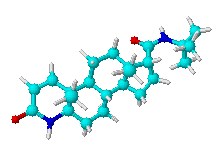Imagine a blog that does more than flatter the ego of its creator and those it links to…imagine a blog that might actually be useful!
Dr Jean-Claude Bradley [no relation] an Associate Professor of Chemistry at Drexel University emailed to tell me that he has set up a blog that will join the dots between real scientific problems and concrete and actionable solutions.
For example, one posting presents 90 molecules that stand a good chance of being inhibitors of the enzyme HIV protease, which is essential to viral replication. “To the best of my knowledge,” Bradley told me, “these compounds have not yet been tested.”
However, in order to complete the trail from problem to solution, he says we need a cheap and efficient synthesis for each of these leads, so that they can be tested in vitro for activity against HIV. “The intended audience for the blog is mainly chemists,” he confesses, “and I would like there to be as much experimental detail provided as required for a chemist to understand fully how to reproduce the porposed and executed syntheses.”
Bradley also revealed that, as you’d expect, he has an organic chemistry lab at his disposal and is willing to execute proposed syntheses, if they make synthetic sense.
Bradley hopes to find similar specific problems in which a chemical synthesis or a specific compound or class or compounds is needed that could make a difference to solving the most important problems facing humanity today.
So, if you’ve got a chemistry degree don’t hang around, go to his blog and save the world!
 Premier molecular modeller Stephan Logan has produced for us a timely reminder of the chemical structure of Tamiflu, the antiviral flu drug. You can order the necessary components to build the Molecular Model of Oseltamivir (Tamiflu) and other molecules from Stephan’s site. Perfect for that avian flu lecture!
Premier molecular modeller Stephan Logan has produced for us a timely reminder of the chemical structure of Tamiflu, the antiviral flu drug. You can order the necessary components to build the Molecular Model of Oseltamivir (Tamiflu) and other molecules from Stephan’s site. Perfect for that avian flu lecture!
 In his otherwise intriguing book, Digital Fortress ($7.99 in paperback from Amazon US), author Dan Brown makes several schoolboy errors. For instance, top of page 69 he says that, “Computer viruses were as varied as bacterial viruses…”
In his otherwise intriguing book, Digital Fortress ($7.99 in paperback from Amazon US), author Dan Brown makes several schoolboy errors. For instance, top of page 69 he says that, “Computer viruses were as varied as bacterial viruses…”